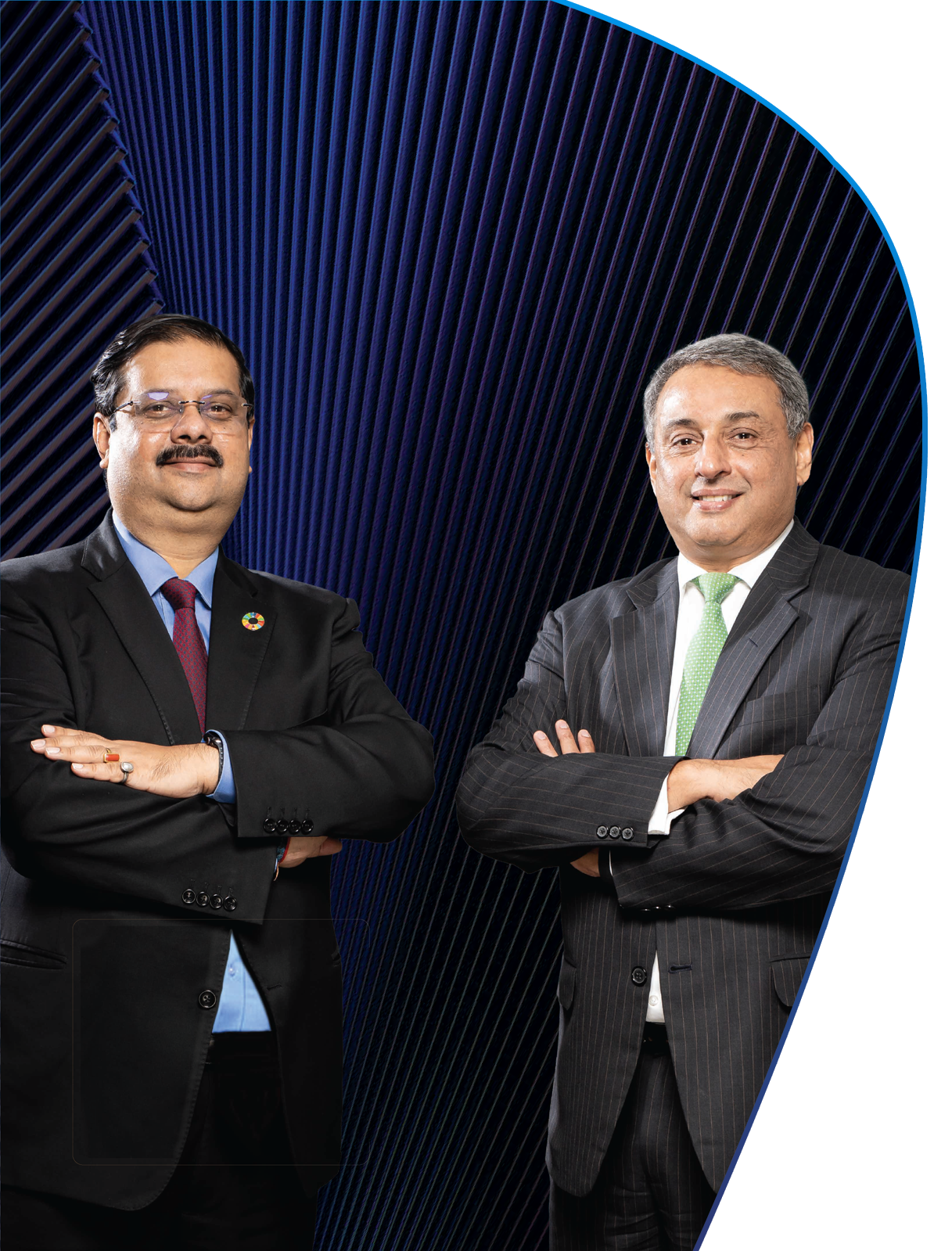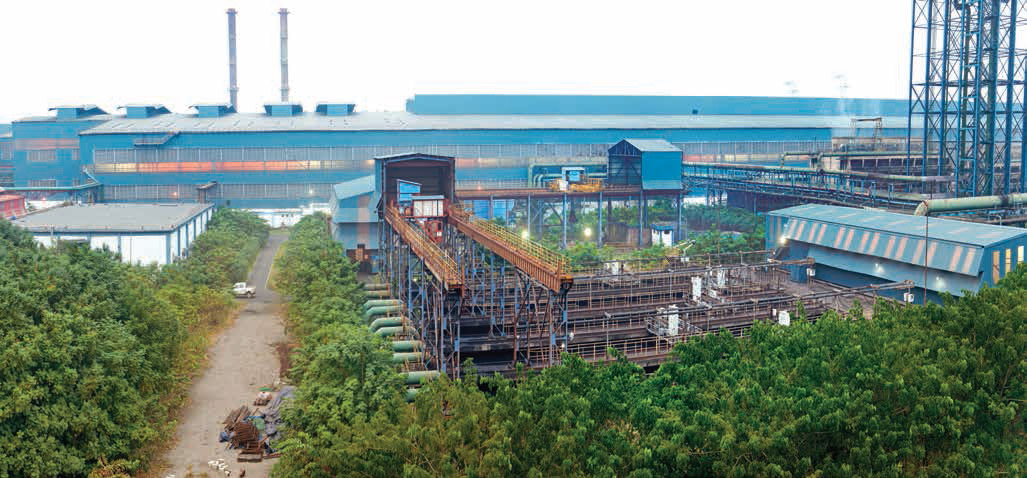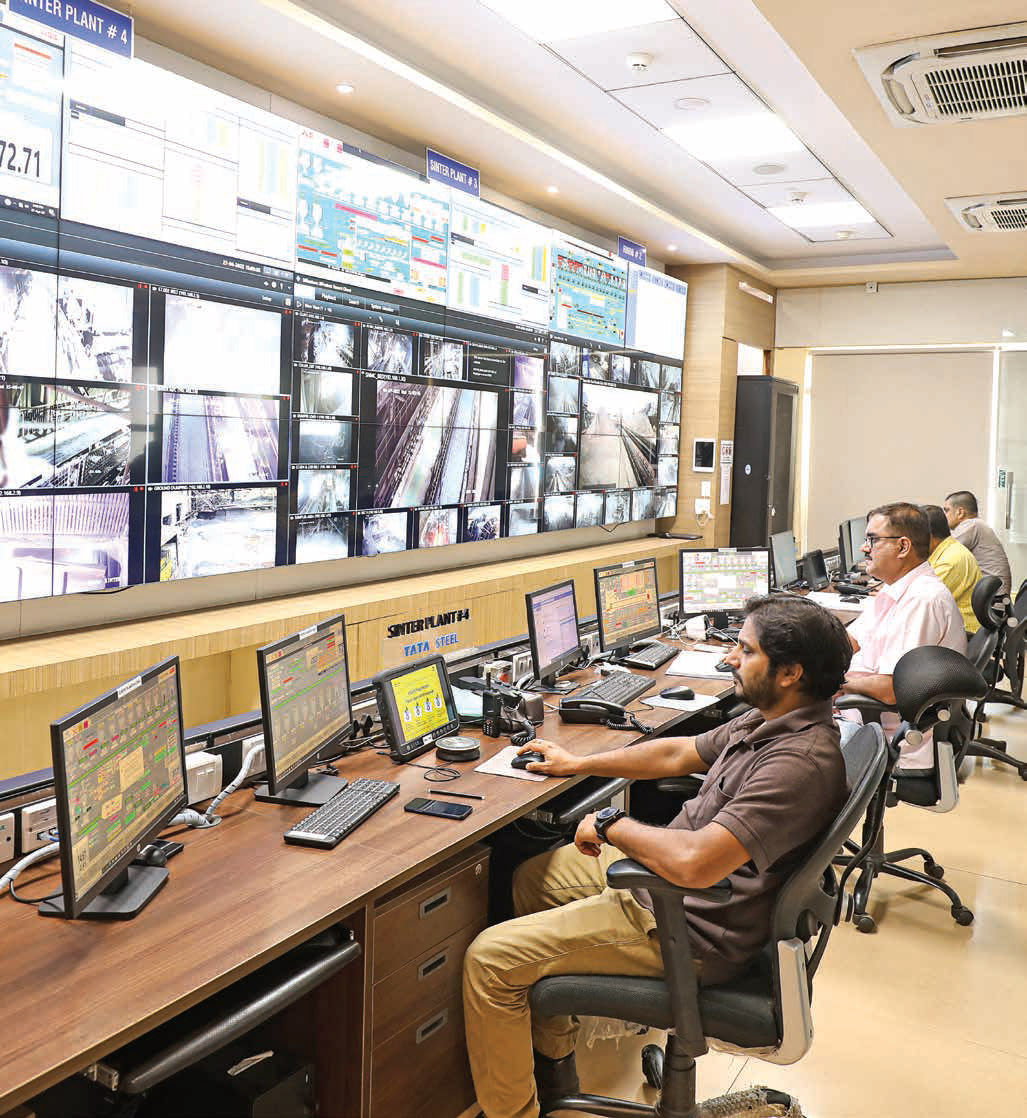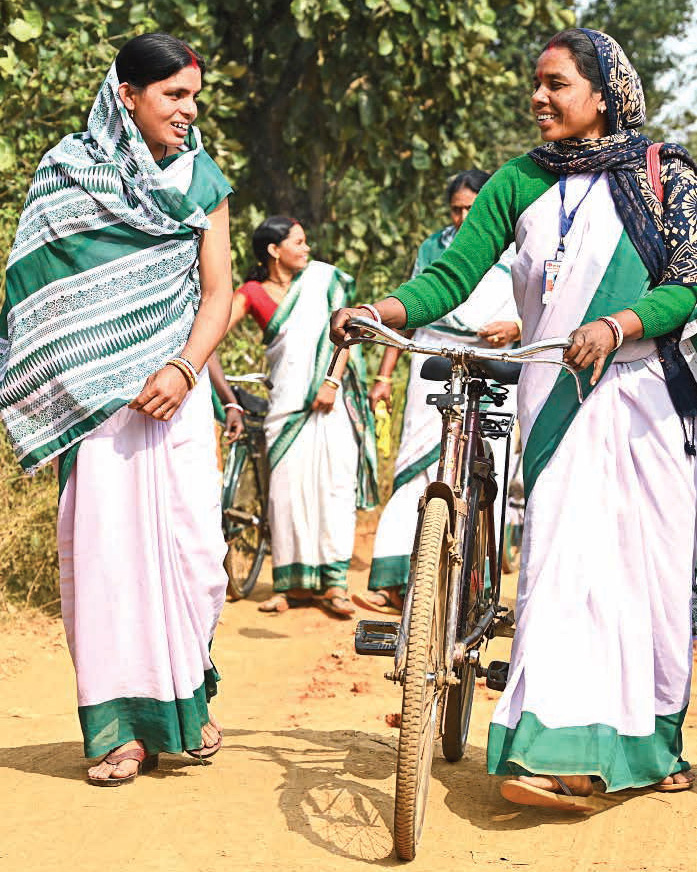
T. V. Narendran (R)
Chief Executive Officer and Managing Director
Koushik Chatterjee (L)
Executive Director and Chief Financial Officer
Q. Thank you for this interaction on the Integrated Report for FY 2021-22. The year gone by saw significant macroeconomic volatility. How did Tata Steel approach the challenges?
Indeed, the world witnessed significant volatility and vulnerability on a broad range of issues covering the second wave of the pandemic, the commodity upcycle and the Russia‑Ukraine war. All of these have had an impact on people, planet, supply chains and business uncertainties across all corporations globally. The way we have looked at it is to enhance our risk management systems and scenario planning processes, stick to the fundamentals, build agility around our decision‑making process, focus on our business and community priorities especially during the pandemic, with COVID care and vaccinations.
Q. Last year was a year of remarkable performance for Tata Steel. Can you provide an overview of the performance of Tata Steel in FY 2021-22?
Well, in a manner of speaking, the performance for FY 2021‑22 reflected at one level the many years of hard work put in by all our colleagues driving continuous improvement, cost take-out, agile decision-making, restructuring, inorganic growth and downstream focus on value-added products. All of this made us fit for the upcycle and in spite of huge volatility of raw materials and steel prices, geopolitical uncertainties and supply chain disruptions, we were able to register our best ever financial performance. So, it’s a tribute to all the employees of the Company across all geographies, and to all our stakeholders of the Company who have always supported and been with the Company at all times.
It is indeed gratifying to report that Tata Steel’s consolidated revenue surged 56% to `2,43,959 crore and profit after tax increased 410% to `41,749 crore. The consolidated crude steel production was at 31.03 MnT, while the total deliveries stood at 29.52 MnT.
In India, the steel business including Tata Steel Long Products generated revenues of `1,35,823 crore, up 53% Y-o-Y. The EBITDA margin for our India operations was around 39% with an EBITDA per tonne of `28,863. The crude steel production crossed 19 MnT for the first time, increasing ~13% on a Y-o-Y basis.
Our Europe business delivered its best ever yearly performance since the acquisition. As European economies recovered from the pandemic, the supply-demand conditions improved, and with improved operating performance, implementation of cost take-out and improvement programs, the business reported strong financial performance with the EBITDA well in excess of a billion pounds. Revenues from our Europe operations for the year were at `90,023 crore and the business generated its highest ever EBITDA since its acquisition of `12,164 crore.

Driving Excellence at Tata Steel Kalinganagar
Considering the year’s financial performance and based on the overall review of the business, the Tata Steel Board has recommended a dividend of ₹51/- per fully paid-up equity share (510% of face value) and proportionate ₹12.75 per partly paid-up equity share, making it the highest ever dividend pay-out in any year for Tata Steel. As part of the overall value creation for the shareholders, the Board has also approved a share sub-division in the ratio of 10:1.
Q. Deleveraging continued to be your focus area for FY 2021-22. Will this continue in FY 2022-23 as well?
Re-shaping the balance sheet has been an enterprise strategy and priority for the Company in the last four years. We had publicly stated that we will de-lever at least one billion dollars per annum and post the acquisition of Bhushan Steel and the Usha Martin Steel Business, we prioritised the de‑leveraging ahead of capital allocation on capex and growth. It was a very critical strategic agenda for the Company and in the last two years, we have reduced our net debt by over `50,000 crore. Tata Steel’s free cash flow was `27,185 crore in FY 2021-22 (`23,748 crore in FY 2020-21) after taking into account the increase in working capital by `9,618 crore due to significant increase in the value of both raw material and finished products, consolidated capex spend of `10,522 crore and income tax paid of `11,902 crore.
We were able to achieve our deleveraging target of US$1 bn within the first six months and prepaid nearly `15,000 crore of debt during the year. We reduced our consolidated net debt from `75,389 crore at the start of the year to `51,049 crore as at March 2022. Consequently, our credit metrics have touched some critical milestones, for example, the net debt to EBITDA was lower than 1x (0.8x at the year end) and the net debt to equity was at 0.52x on a consolidated basis. This was well acknowledged by the rating agencies and we have been upgraded to investment grade 'BBB-' credit rating with a positive outlook by S&P.
Moving forward, Tata Steel is committed to balancing its priorities of allocating significant capital towards value‑accretive projects and businesses while also continuing to strengthen its balance sheet through deleveraging. A strong balance sheet with healthy cash flows will enable us to fuel our future growth ambitions and weather any economic uncertainties.
Q. What are your capex plans for the Company in FY 2022-23?
Our long-term vision is to grow in India, keeping pace with the growth of demand in the country. Based on our assessment of the opportunities in the Indian market, we will calibrate our growth plans and timing for implementation. We are currently focussed on completing our expansion project in Kalinganagar to create a state-of-the-art 8 MnTPA site. During FY 2022-23, we will be commissioning the Pellet Plant, which is 70% complete, and the phase-wise commissioning of the Cold Rolling Mill Complex, starting with the pickling line and the cold rolling mill. Both are margin expansionary projects as part of the overall expansion project in Kalinganagar. This expansion in Kalinganagar is focussed on higher value-added products including plates, coated products, advanced high strength steels and products for newer applications.
During FY 2022-23, Tata Steel will focus on growing its steelmaking capacity in India, adding to our downstream value-added products, strengthening our supply chain through necessary investments in logistics and infrastructure, investments in newer ventures and services & solutions, and defining a de-carbonised future for our Europe business. Apart from the above, we are working on a number of downstream projects which will continue adding value to our product portfolio. We are ready to commission the first phase of doubling our ductile iron pipes facilities in Tata Metaliks in Kharagpur. Some of the other notable ones where we will be allocating capital spend includes setting up a 0.5 MnTPA Special Bar and Wire Rod-Combi Mill in Jamshedpur which is focussed on the automotive market. We are also starting capital spend on doubling the tinplate capacity by expanding the plant by 0.3 MnTPA.
During FY 2022-23, one of the largest capital allocations will be on the acquisition of Neelachal Ispat Nigam Limited (NINL), within the first quarter of the financial year. NINL is particularly important given its proximity to Tata Steel’s Kalinganagar site and its potential to become the long products business hub in the future.
During FY 2022-23, one of the largest capital allocations will be on the acquisition of Neelachal Ispat Nigam Limited (NINL), within the first quarter of the financial year. NINL is particularly important given its proximity to Tata Steel’s Kalinganagar site and its potential to become the long products business hub in the future. Although the plant has been non-operational for some time, we expect to start operations in about six months from the transaction closure in a phased manner and will endeavour to ramp-up to its rated billet making capacity of 1.1 MnTPA within 12 months, subject to receiving regulatory clearances.
Our strategy and timing of expansion of steel capacity in India will be based on the underlying demand projections, regulatory conditions, balance sheet prudence and value enrichment of the product portfolio.
Q. Tata Steel has also ventured into New Materials Business. How do you see the future of this business?
In the New Materials business, we are diversifying our product offering beyond steel by introducing new materials in three major verticals – Composites, Graphene and Medical Materials & Devices. We have already put in place a graphene production capacity of 100 TPA and now we are investing in the production of medical materials at scale, which has significant market opportunity in India. The first medical material of choice is Hydroxyapatite – a calcium phosphate‑based ceramic-used in orthopaedic coating on implants, dental implants, bone fillers, cosmetics as well as consumer products. We believe that our strengths of strong materials research and development, branding and marketing & sales reach, provide us an opportunity to deliver world-class quality of bio-ceramics through a reliable supply chain to customers at a competitive cost and scale.
Q. How do you see the Russia-Ukraine conflict impact Tata Steel’s overall business?
The war has certainly created supply constraints of steel, especially in Europe as Russia and Ukraine were among the largest exporters of finished steel to Europe before the conflict. Till recently, Russia has been the second largest supplier of PCI (Pulverised Coal Injection) coal globally after Australia. It is well-known that Russia represented the largest share of energy (thermal coal and natural gas) exports to Europe. As a result of the conflict, therefore, there have been significant supply disruptions and upward price pressures and volatility in steel prices, coking coal, iron ore, freight and natural gas. As the conflict lingers, it will have second order macro-economic effects on growth rates, inflation and monetary policy in various countries.

Integrated Sinter Plant Operations Centre (iSPOC) initiative to enable remote operations of Sinter Plant at Jamshedpur Works
Q. What is Tata Steel doing to advance its Corporate Sustainability Practices?
For Tata Steel, sustainability is the core of its corporate DNA since inception 115 years ago. It has become more formalised in recent years. We also work on prioritising the United Nations Sustainable Development Goals (SDGs). We have prioritised 15 SDGs based on how we impact them and, in turn, how these SDGs impact us.
Within the SDGs, we are focussed on the targets for greenhouse gas (GHG) emission, specific fresh-water consumption and circular economy. We are also striving to enhance our green product portfolio. Last year, our products under Rebar and Tube categories earned their GreenPro Ecolabel Certification.
In the thought leadership space, we are active in a number of global platforms including in the TCFD and the recently launched Taskforce on Nature-related Financial Disclosures (TNFD), working towards improvement of disclosure practices and nature positive outcomes. As a responsible corporate, we support the United Nations Global Compact (UNGC) and strive to integrate its 10 principles in all facets of our business. Tata Steel has also earned the distinction of becoming the first steel producer in the world to join the Sea Cargo Charter (SCC) to reduce Scope 3 GHG emissions in ocean trade.
In pursuance of our decarbonisation targets, Tata Steel commissioned the 5 tonnes per day (TPD) CO2 capture plant to extract CO2 directly from blast furnace gas and introduced electric vehicles in our fleet for transportation of steel. Addressing water sustainability through Reduce, Reuse, Recycle framework, Tata Steel commissioned a 3,000 KLD water treatment plant at Noamundi mines to ensure clean water for the community.
Tata Steel’s commitment to investing in circular economy saw us fully commission a 0.5 MnTPA steel recycling plant at Rohtak, Haryana which will contribute to conserving valuable resources and reducing landfills.
Both, Tata Steel UK and Tata Steel Netherlands have been developing detailed plans for transition to low CO2 technologies in line with our ambition to produce CO₂ neutral steel by 2050 in Europe. In Tata Steel Nederland, we plan to gradually phase out our blast furnaces and coal over the next 10 years by replacing them with a combination of Direct Reduced Iron (DRI) technology based on hydrogen, and electric furnaces.
We are pioneering sustainability across our supply chain through partnerships for responsible sourcing and distribution. For our supply chain sustainability efforts, Tata Steel was recognised as 'Supplier Engagement Leader' 2021 by CDP for effectively taking actions to measure and reduce environmental risks across its supply chain.
We are happy to share that in recognition of our efforts, Tata Steel has been recognised as the Steel Sustainability Champion for the fifth year in a row by worldsteel and is also a member of worldsteel’s New Sustainability Charter, thus, reaffirming our commitment towards achieving industry leadership in sustainability.
Q. The global reporting landscape is rapidly evolving with investors and regulators looking for deeper insights on sustainability related risks and opportunities of companies. How is Tata Steel responding to this need?
Tata Steel has been an early adopter of sustainability reporting. We were the first company in India to start publishing Global Reporting Initiative (GRI) based Sustainability Report in 2001, and in FY 2015-16 we adopted the International Integrated Reporting Framework as one of the first companies in India to do so.
We have also been participating in Dow Jones Sustainability Indices (DJSI) assessment since 2012, where we feature amongst the top 10 steel companies in the world. We have also been participating in CDP’s Climate Change, Supply Chain and Water disclosures since 2006, 2012 and 2014 respectively.
Going forward, Tata Steel fully recognises that investors increasingly consider financial and ESG information in their investment decision-making. The global reporting landscape is also rapidly evolving with alignment of various disclosure standards globally under the IFRS Foundation and we recognise the importance of the newly set up International Sustainability Standards Board (ISSB) that will harmonise non-financial reporting globally. We are fully engaged in supporting the development of national and global disclosure regime and their adoption in due course. Tata Steel will stay committed to enhancing transparency in non‑financial reporting in the future.
Q. You have always shared that People and Community are your foremost priority. How do you demonstrate your commitment towards them?
Yes, our people are indeed our most valuable resource and will remain the topmost priority. At Tata Steel, our vision is to build a workplace where we embrace differences in individuals and create an inclusive culture. In our journey towards equity, inclusion and diversity, we are working across our processes of recruitment, sensitisation, retention, and development, besides making relevant investments in infrastructure. Our endeavour is to create an environment that fosters a culture of trust, integrity, empathy and respect for every individual.
In a landmark initiative, we onboarded transgender persons as Heavy Earth Moving Machinery and Crane operators at our mines. We have also widened opportunities for employment of women across all sections of our mines.
Our efforts have won us the Great Place to Work® recognition for the fifth time in Manufacturing and we have featured amongst the top 30 companies in India for our people‑first approach, diversity and inclusion, and agile working model initiatives.
Tata Steel recently also joined the Global Parity Alliance (GPA) by the World Economic Forum as one of its founding members to accelerate diversity, equity and inclusion (DE&I) at the workplace and beyond.
A core tenet for us is to be partners in progress for communities which are the least served and underrepresented. Last year, we contributed `406 crore towards CSR expenditure and our programmes reached about 2.87 million beneficiaries. We continued our work in the areas of healthcare, education, livelihood and providing access to drinking water. We revamped the medical care infrastructure across our operating locations to better deal with health emergencies in the future.
Our signature healthcare program, Maternal and Newborn Survival Initiative (MANSI) bagged the BRICS Solutions for SDGs Award under Good Health and Wellbeing category (SDG 3).
Our efforts have won us the Great Place to Work® recognition for the fifth time in Manufacturing and we have featured amongst the top 30 companies in India for our people first approach, diversity and inclusion, and agile working model initiatives.
We also developed and adopted a business and human rights policy which recognises individuals and communities as holders of human rights and confirmed our commitment towards upholding human rights as an integral aspect of doing business.
The community continues to be at the core of our enterprise strategy. The scale of our community engagement throughout the various waves of the pandemic is a testament to our commitment to always working with society, local stakeholders and the region or countries we work in, as a responsible corporate citizen. Our agile and meaningful response to the pandemic reached more than 1.82 million people through a 10-point #combatcovid19 programme, to (a) address information, awareness and material deficits, (b) create income opportunities to bridge livelihood deficits and (c) strengthen public systems to last beyond the pandemic. These have been over and above the yeoman efforts of Tata Main Hospital, Jamshedpur and the network of other hospitals, creating a dedicated COVID-19 treatment and care infrastructure, including 19 oxygen plants in remote locations of Eastern India.
Tata Steel introduced the social security COVID-19 family protection scheme for the families of all the employees, who lost their lives due to the pandemic, to ensure an honourable standard of living for their families.
Our employee volunteering efforts continue to resonate with the local communities, and we will continue to strive to make a real difference with our initiatives.

Augmenting capabilities of Sahiyyas Sathis, part of Tata Steel’s flagship health programme, Maternal and Newborn Survival Initiative (MANSI)